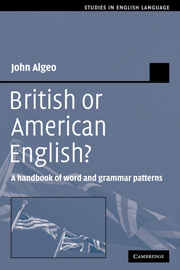Summary
British and American as national varieties
There are many varieties of English other than British (here the English of the United Kingdom) and American (here the English of the United States). All of those other varieties are intrinsically just as worthy of study and use as British and American. But these two varieties are the ones spoken by most native speakers of English and studied by most foreign learners. They have a special status as the two principal national varieties of the language simply because there is more material available in them than in any other variety.
British is the form of English now used in the country whence all other forms of English have ultimately derived. But present-day British is not the origin of any other variety of the language; rather it and all the other varieties are equally descendant from a form of English spoken in the British Isles in earlier times. In some respects, present-day British is closer to the common ancestral form of the present-day varieties than is American or other varieties; but in other respects the reverse is true, and American, for instance, preserves older uses that became obsolete in British use. To mistake present-day British for the ancestor of all other forms of English is a logical and factual error.
- Type
- Chapter
- Information
- British or American English?A Handbook of Word and Grammar Patterns, pp. 1 - 8Publisher: Cambridge University PressPrint publication year: 2006



